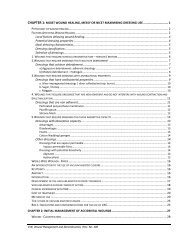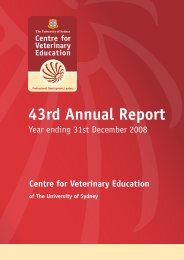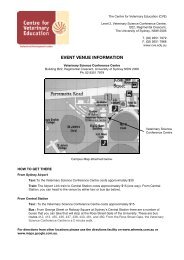permethrin intoxication of cats bibliography - Centre for Veterinary ...
permethrin intoxication of cats bibliography - Centre for Veterinary ...
permethrin intoxication of cats bibliography - Centre for Veterinary ...
Create successful ePaper yourself
Turn your PDF publications into a flip-book with our unique Google optimized e-Paper software.
CITATION YEAR COUNTRY<br />
<strong>of</strong><br />
AUTHOR<br />
Dorman, D. C., W. B. Buck, et al. (1990).<br />
"Fenvalerate/N,N-diethyl-m-toluamide (Deet)<br />
toxicosis in two <strong>cats</strong>." Journal <strong>of</strong> the American<br />
<strong>Veterinary</strong> Medical Association 196(1): 100-2.<br />
Durand, F. (1993). Risques toxiques des insecticides<br />
pyrethroides pour les carnivores domestiques etude<br />
epidemiologique d'apres les cas du centre antipoison<br />
veterinaire de lyon (1990-1992). Ecole Nationale<br />
Veterinaire de Lyon. Lyon, Université Claude<br />
Bernard. Doctorat vétérinaire: 139.<br />
Dyer, F., E. Brown, et al. (2009). "Suspected adverse<br />
reactions, 2008." <strong>Veterinary</strong> Record. 165(6):<br />
162-164.<br />
Dyer, F., M. Spagnuolo-Weaver, et al. (2006).<br />
"Suspected adverse reactions, 2005." <strong>Veterinary</strong><br />
Record. 158(14): 464-466.<br />
Dyer, F., M. Spagnuolo-Weaver, et al. (2007).<br />
"Suspected adverse reactions, 2006." <strong>Veterinary</strong><br />
Record. 160(22): 748-750.<br />
NOTES<br />
complexes, neurotransmitters, and ATPases. Toxicity is a function <strong>of</strong> chemical<br />
structure, metabolism, route <strong>of</strong> exposure, and the presence or absence <strong>of</strong> synergists.<br />
Pyrethroid insecticides are neurotoxic, and the development and severity <strong>of</strong> clinical<br />
signs is proportional to the nervous tissue pyrethroid concentration. Type I pyrethroid<br />
poisoning in mice and rats produces a syndrome characterized by tremors, prostration<br />
and altered startle reflexes. Type II pyrethroid poisoning in mice and rats causes<br />
ataxia, convulsions, hyperactivity, choreoathetosis and pr<strong>of</strong>use salivation. A<br />
presumptive diagnosis <strong>of</strong> pyrethrin/pyrethroid poisoning is based upon history <strong>of</strong><br />
exposure, development <strong>of</strong> appropriate clinical signs, and chemical analysis <strong>for</strong><br />
insecticide residues. Treatment <strong>of</strong> pyrethrin and pyrethroid toxicosis involves basic life<br />
support, seizure control when needed, and the prevention <strong>of</strong> further insecticide<br />
absorption.<br />
1990 USA Toxicosis attributable to fenvalerate and N,N-diethyl-m-toluamide (Deet) exposure was<br />
suspected in 2 <strong>cats</strong>. Clinical signs <strong>of</strong> toxicosis developed within 4 to 6 hours <strong>of</strong> dermal<br />
application <strong>of</strong> the pesticide. Clinical signs <strong>of</strong> toxicosis seen in both <strong>cats</strong> included<br />
hypersalivation, ataxia, and depression. In addition, seizures were seen in 1 cat. Both<br />
<strong>cats</strong> died. Analysis <strong>of</strong> skin, kidney/urine, liver, and brain tissues confirmed the presence<br />
<strong>of</strong> fenvalerate and Deet. The pyrethroid fenvalerate and the insect repellent Deet are<br />
used <strong>for</strong> the control <strong>of</strong> fleas and ticks on <strong>cats</strong>. Suspected fenvalerate/Deet toxicosis in<br />
<strong>cats</strong> is associated with tremors, hypersalivation, ataxia, vomiting, depression, and<br />
seizures.<br />
1993 France Les pyrethroides <strong>for</strong>ment une famille d'insecticides de toxicite importante pour les<br />
animaux a sang froid et meconnue pour les homeothermes. le CNITV-Lyon a<br />
enregistre sur une periode de trois ans 345 cas d'<strong>intoxication</strong>s certaines de chiens et<br />
de chats par les pyrethroides. Leurs risques toxiques sont reevalues. L'etude de ces<br />
<strong>intoxication</strong>s a permis d'analyser leurs circonstances afin de mieux les prevenir.<br />
2009 UK<br />
2006 UK PERMETHRIN Of the 86 cases resulting from use in an unauthorised species, 64 (74.4<br />
per cent) occurred in <strong>cats</strong>, representing a decrease <strong>of</strong> 19 in this species compared with<br />
2004. The incidence <strong>of</strong> adverse reactions in <strong>cats</strong> resulting from the unauthorised use <strong>of</strong><br />
canine ‘spot-on’ products containing <strong>permethrin</strong> showed a corresponding decrease,<br />
from 0.0022 per cent in 2004 to 0.0013 per cent in 2005.<br />
2007 UK PERMETHRIN Of the 89 cases resulting from use in an unauthorised species, 77<br />
(83.7%) occurred in <strong>cats</strong>, representing an increase <strong>of</strong> 13 in this species compared with<br />
2005. The incidence <strong>of</strong> adverse reactions in <strong>cats</strong> resulting from the unauthorised use <strong>of</strong><br />
PERMETHRIN INTOXICATION OF CATS 28 Novermber 2009 Page 10 <strong>of</strong> 26






